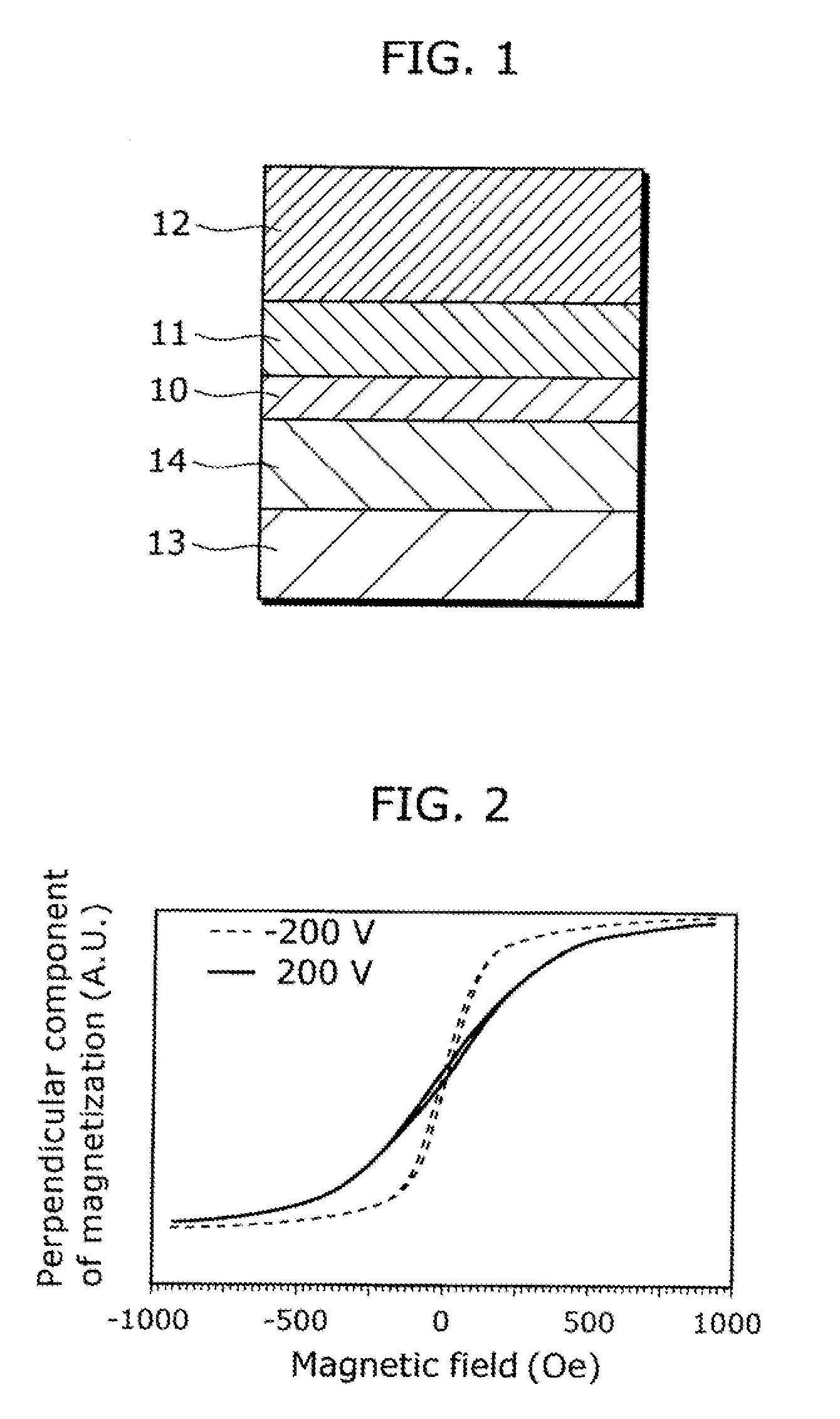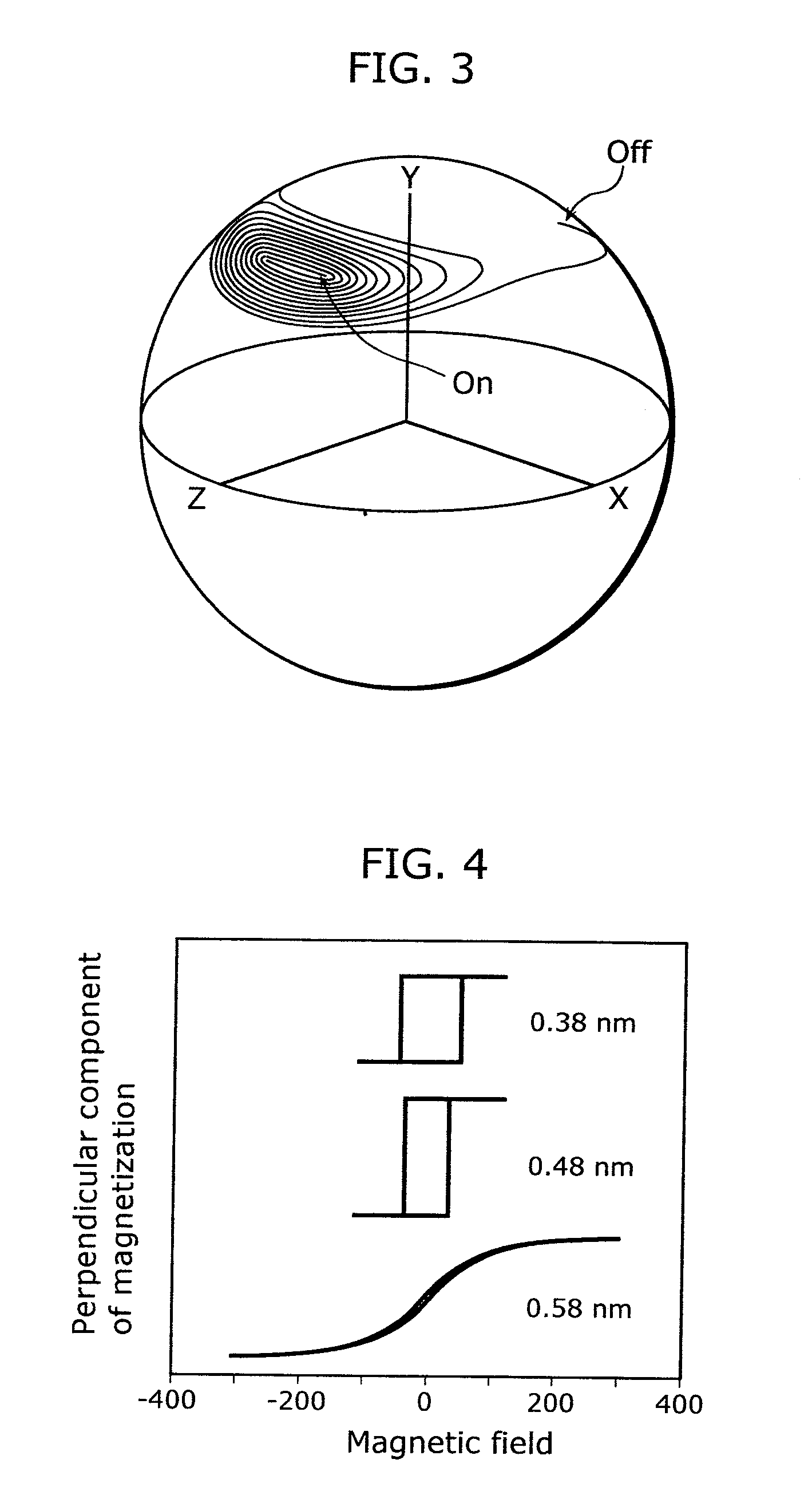Magnetization control method, information storage method, information storage element, and magnetic function element
a control method and information storage technology, applied in the field of information storage method, information storage element, and magnetic function element, can solve the problems of low writing speed in the s order, low rewriting frequency, high possibility, etc., and achieve the effect of increasing writing current and low power consumption
- Summary
- Abstract
- Description
- Claims
- Application Information
AI Technical Summary
Benefits of technology
Problems solved by technology
Method used
Image
Examples
embodiment 1
[0066]FIG. 1 is a cross-sectional view of a magnetic function element according to Embodiment 1 in the present invention.
[0067]In the magnetic function element, a magnetic layer 10, which is to be magnetically-controlled by having a voltage applied, is provided on a substrate 13 via a base layer 14; and an insulating layer 11, which works as a potential barrier, is provided in contact with the magnetic layer 10. Above the insulating layer 11, an electrode 12 is provided to apply a voltage to the magnetic layer 10.
[0068]The following substrates, for example, can be used as the substrate 13: a semiconductor substrate such as a silicon substrate, a plastic substrate, a glass substrate, a sapphire substrate, and a magnesium oxide substrate; and an insulating substrate.
[0069]The base layer 14 may be formed of: a layer made of (i) a noble metal including the following: gold (Au), silver (Ag), copper (Cu), aluminum (Al), chrome (Cr), and ruthenium (Ru), and (ii) a transition metal element;...
embodiment 2
[0093]FIG. 10 is a cross-sectional view of a magnetic function element according to Embodiment 2 in the present invention.
[0094]The magnetic function element has the magnetic layer 10 and the insulating layer 11 of Embodiment 1 switch their positions. The insulating layer 11, working as a potential barrier, is provided on the substrate 13 and the base layer 14. Here, the base layer 14 can be also used as a bottom electrode. On the insulating layer 11, the magnetic layer 10 is provided. Here, the magnetization reversal of the magnetic layer 10 is to be induced by an electric field. A voltage is applied between the electrode 12 provided on the magnetic layer 10 and the base layer 14.
[0095]As described above, the magnetic function element according to an implementation of the present invention includes a structure having: the magnetic layer 10 which is an ultrathin film ferromagnetic layer having a film thickness of one or more atomic layers and of 2 nm or less; and the insulating laye...
embodiment 3
[0096]FIG. 11 is a cross-sectional view of a magnetic storage element (information storage element) according to Embodiment 3 in the present invention.
[0097]The magnetic storage element works as a single memory cell. The magnetic storage element is structured to have an extra magnetic layer (reference layer) 20 on the insulating layer 11 found in the magnetic function element according to Embodiment 1. A storage layer 21 is considered and structured in a similar manner (materials and film thickness) as the magnetic layer 10 in the magnetic function element according to Embodiment 1.
[0098]Including ferromagnetic metal, the reference layer 20 is sandwiched between the electrode 12 and the base layer 14, and stacked opposite the insulating layer 11 in relation to the storage layer 21. The reference layer 20 is made of the same material as the magnetic layer 10 is made. The magnetized state of the reference layer 20 remains fixed. Information is written by applying a voltage to control ...
PUM
| Property | Measurement | Unit |
|---|---|---|
| thickness | aaaaa | aaaaa |
| voltage | aaaaa | aaaaa |
| coercive force | aaaaa | aaaaa |
Abstract
Description
Claims
Application Information
 Login to View More
Login to View More - R&D
- Intellectual Property
- Life Sciences
- Materials
- Tech Scout
- Unparalleled Data Quality
- Higher Quality Content
- 60% Fewer Hallucinations
Browse by: Latest US Patents, China's latest patents, Technical Efficacy Thesaurus, Application Domain, Technology Topic, Popular Technical Reports.
© 2025 PatSnap. All rights reserved.Legal|Privacy policy|Modern Slavery Act Transparency Statement|Sitemap|About US| Contact US: help@patsnap.com



